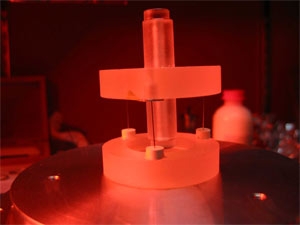Fellow Jan Hall has been working on stabilizing the frequency of lasers since the 1960s. Now, he, JILA Research Associate Mark Notcutt, Long-Sheng Ma (currently at BIPM in France), and Fellow Jun Ye have devised an improved, compact, and less expensive method for stabilizing lasers. The new method is based on a small, vertically mounted optical cavity (shown on the right). Because the cavity is supported exactly in the middle, the top and bottom halves change in length by equal and opposite amounts in response to vibrations.
Because the total cavity length always stays the same, its sensitivity to vibration and gravity falls by a factor of 100. In fact, Mark and Ma showed that, for their lasers, cavity performance was likely limited by the random, or Brownian, motion of its mirrors. The cavity performs better than comparably sized systems, and it is smaller and less expensive than NIST's best performing system. These features make it ideal for new research projects requiring an affordable precision laser. Judging by the level of interest, the researchers expect it to have some interesting applications in light-based radar (lidar), gravity wave antennas, quantum optics experiments, and optical atomic clocks. In JILA, it is playing a role in Jun's strontium-based optical frequency standards and precision spectroscopy, particularly in cases that require laser coherence times longer than a few seconds. For the latter purpose, Andrew Ludlow in Jun's group built a frequency-stabilized laser based on the new cavity design. Seth Foreman's frequency comb was able to connect and compare two different wavelength lasers to characterize the new cavity system and show that the new cavity's frequency stability is ultimately limited by the Brownian motion of its mirrors.
Many of the findings reported here appeared in the July 15 (2005) issue of Optics Letters. Mark Notcutt leaves JILA to join Coherent Technologies in Lafayette, CO, in October. The researchers on this project say they couldn't have done it without help from JILA's instrument and electronics shops. - Julie Phillips



 The Physics Frontiers Centers (PFC) program supports university-based centers and institutes where the collective efforts of a larger group of individuals can enable transformational advances in the most promising research areas. The program is designed to foster major breakthroughs at the intellectual frontiers of physics by providing needed resources such as combinations of talents, skills, disciplines, and/or specialized infrastructure, not usually available to individual investigators or small groups, in an environment in which the collective efforts of the larger group can be shown to be seminal to promoting significant progress in the science and the education of students. PFCs also include creative, substantive activities aimed at enhancing education, broadening participation of traditionally underrepresented groups, and outreach to the scientific community and general public.
The Physics Frontiers Centers (PFC) program supports university-based centers and institutes where the collective efforts of a larger group of individuals can enable transformational advances in the most promising research areas. The program is designed to foster major breakthroughs at the intellectual frontiers of physics by providing needed resources such as combinations of talents, skills, disciplines, and/or specialized infrastructure, not usually available to individual investigators or small groups, in an environment in which the collective efforts of the larger group can be shown to be seminal to promoting significant progress in the science and the education of students. PFCs also include creative, substantive activities aimed at enhancing education, broadening participation of traditionally underrepresented groups, and outreach to the scientific community and general public.